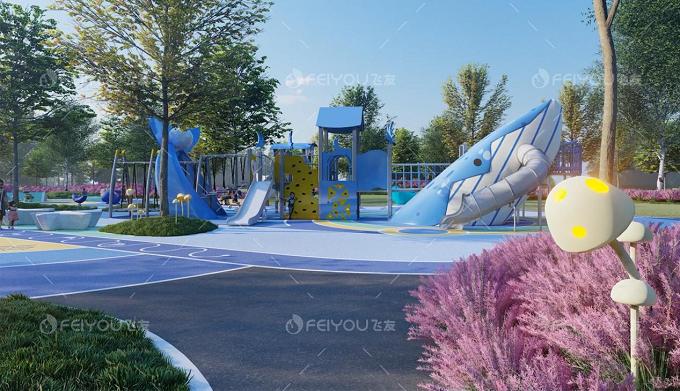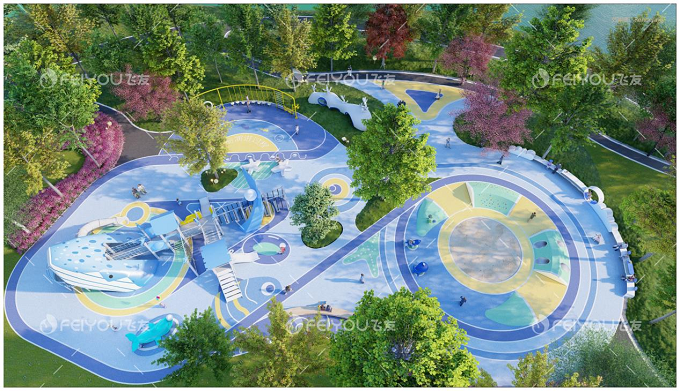Outdoor amusement facilities play an important role in the process of children's growth. Compared with traditional powered play equipment, unpowered kiddie rides have gradually occupied a place in the market with their unique features and advantages. In this paper, we will discuss the definition of unpowered children's play equipment, market analysis, product recommendation, design principles, case study and future outlook.
I. Definition and characteristics of unpowered children's amusement facilities
Non-powered kiddie rides usually refer to kiddie rides that do not need to be driven by electricity or other external power sources. Such facilities are usually based on natural elements and structured spaces, such as climbing frames, swings, slides, sandboxes, etc. Unpowered children's play equipment is characterized by its reliance on physical principles and children's behavior to produce entertainment effects, such as gravity and friction.

Second, market analysis: demand and status quo
With the increasing attention to children's healthy growth, the market demand for unpowered children's amusement facilities shows a rising trend. In city parks, kindergartens, residential neighborhoods and other public spaces, unpowered children's play equipment has gradually become a necessary outdoor play equipment. However, the quality of unpowered children's play equipment on the market is uneven, and the design and safety performance of some facilities need to be improved.
Product recommendation: products for different age groups and needs
For children of different age groups and needs, we recommend the following types of non-powered play equipment:
Toddler area: sandboxes, climbing frames, small slides and so on. These facilities are highly entertaining and safe for young children.
Preschool area: swings, climbing frames, jump ropes and so on. These facilities can help preschoolers exercise physical coordination and teamwork.
School-age children's area: three-dimensional maze, climbing wall, table games, etc.. These facilities can exercise school-age children's intelligence and physical coordination.
Fourth, the design principles: safety, fun, comfort
In the design of powerless children's amusement facilities, safety, fun and comfort are three important design principles. First, safety is the most important consideration. Facilities should use high-quality materials and conduct adequate safety testing to ensure the safety of children during play. Second, fun is the key to attracting children. The design of the facility should be creative and interactive to stimulate children's curiosity and desire to explore. Finally, comfort is also a factor to consider. Facilities should be ergonomically designed to provide children with a comfortable playing environment.
V. Case Study: Advantages and Disadvantages in Practical Application
Taking a city park's powerless children's play facilities as an example, its design advantages are that it makes full use of the natural environment, the shape and color of the facilities are in line with children's aesthetics, and it has a high level of safety. However, its shortcomings are the lack of interesting interaction and the comfort of some facilities needs to be improved. To address these issues, we can propose the following improvement measures: add challenging and interactive elements, such as climbing walls and interactive games; optimize the comfort of the facilities, such as adding soft packaging and optimizing cushions.

VI. Future Prospects: Development Trend and Enhancing Competitiveness
With the advancement of technology and changes in people's lifestyles, unpowered children's play facilities will face new challenges and opportunities. In the future, these facilities may develop in a more intelligent, diversified and personalized direction. For example, by introducing Internet of Things (IoT) technology, we can realize remote monitoring and maintenance of the facilities to improve operational efficiency; meanwhile, by utilizing virtual reality (VR) technology, we can create a more immersive play experience for children. In addition, by cooperating with educational institutions, powerless children's rides can become a place for fun and education, allowing children to learn more during play.
In order to enhance the competitiveness and adaptability of products, manufacturers need to continuously optimize the design and focus on user experience. For example, in terms of safety, they should continue to improve the material and structure to increase the durability and risk resistance of the products; in terms of fun, they can introduce more interactive elements and creative design to stimulate children's curiosity and desire to explore; in terms of comfort, they should pay attention to ergonomic design to provide a more comfortable and natural environment for children to play.
In conclusion, as an environmentally friendly, economical and creative way of children's entertainment, powerless children's amusement facilities will continue to play an important role in the future development. We should pay attention to its development trend and continuously optimize product design and user experience to adapt to market changes and meet children's needs.
+86-13566236059
#16 Chuangqiang Road, Light industrial area, Lucheng district, Wenzhou city, Zhejiang Province, China.
+86-577-85951908
+86-577-86457291
